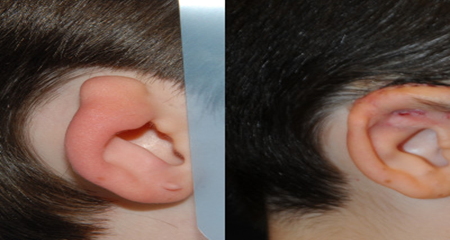Microtia Treatment: Why Ear Reconstruction Shines
Microtia Treatment: Why Ear Reconstruction Shines

Microtia, a congenital condition where the external ear is underdeveloped or absent, affects thousands of individuals worldwide. While it may seem like a purely cosmetic concern, microtia can also impact hearing and self-esteem, making effective treatment essential. Ear reconstruction surgery has emerged as a transformative solution, offering both functional and aesthetic benefits. In this blog, we’ll explore the basics of microtia, its causes and symptoms, the various treatment options available, and why ear reconstruction stands out as a life-changing procedure.
Understanding Microtia
Microtia is a rare condition that occurs in approximately 1 in every 8,000 to 10,000 births. The term "microtia" comes from the Greek words for "small ear," and it describes a spectrum of ear deformities ranging from minor structural abnormalities to the complete absence of the external ear (anotia). The condition can affect one or both ears, with unilateral microtia being more common.
The ear is a complex structure, and its underdevelopment can impact not only appearance but also hearing. The external ear plays a crucial role in capturing sound waves and directing them into the ear canal. When microtia is present, the ear canal may also be underdeveloped or absent, leading to conductive hearing loss.
Causes, Symptoms, and Common Concerns
The exact cause of microtia remains unclear, but researchers believe it results from a combination of genetic and environmental factors. Some studies suggest that maternal diabetes, certain medications, or nutritional deficiencies during pregnancy may increase the risk. However, in most cases, microtia occurs sporadically without a clear cause.
Symptoms of microtia include:
- A small, misshapen, or absent external ear
- Partial or complete closure of the ear canal
- Conductive hearing loss
Beyond the physical symptoms, microtia can have a profound emotional impact. Children and adults with microtia may experience self-consciousness, social anxiety, or difficulty in social interactions due to their appearance. Addressing these concerns through effective treatment is crucial for improving quality of life.
Treatment Options for Microtia
Ear Reconstruction SurgeryEar reconstruction is the gold standard for treating microtia. This procedure involves creating a new ear using either the patient’s own tissue (autologous reconstruction) or a synthetic implant. Autologous reconstruction typically uses cartilage from the rib cage to sculpt a natural-looking ear. This method is highly durable and grows with the patient, making it ideal for children.
Bone-Anchored Hearing Aids (BAHA)For patients with hearing loss, BAHA devices can be surgically implanted to improve sound conduction. These devices bypass the underdeveloped ear canal and directly stimulate the inner ear.
Prosthetic EarsIn some cases, a prosthetic ear may be recommended, especially for patients who are not candidates for surgery. Modern prosthetics are custom-made and can look incredibly realistic.
Non-Surgical OptionsFor mild cases of microtia, non-surgical treatments like ear molding may be effective, particularly in newborns. This technique uses splints to reshape the ear during the early weeks of life when the cartilage is still soft and malleable.
Why Ear Reconstruction Stands Out
- Natural Appearance: Advances in surgical techniques allow surgeons to create ears that look and feel natural.
- Improved Self-Esteem: Restoring a normal ear appearance boosts self-confidence and social ease.
- Customization: Each reconstruction is tailored to the individual’s anatomy for the best results.
- Long-Term Results: Reconstructed ears are permanent and grow naturally with the patient.
Meet Dr. Vinay Jacob
When it comes to ear reconstruction and other complex plastic and reconstructive surgeries, Dr. Vinay Jacob is a name you can trust. With over 25 years of experience, Dr. Jacob is a highly qualified Senior Plastic and Reconstructive Surgeon in India. He earned his MBBS from St. John’s Medical College, Bangalore, and holds an MS from Tata Memorial Hospital, Mumbai. He further specialized with an MCh and DNB in Plastic Surgery, earning distinction for his expertise.
Dr. Jacob specializes in a wide range of procedures, including Gender-Affirming Surgeries, Hand & Facial Rejuvenation, Nasal & Respiratory Surgery, Limb Salvage & Prosthetics Integration, and Breast Reconstructive Surgery. His compassionate approach and commitment to excellence have made him a trusted name in the field.
Clinic Address: 503, Sagar Fortune Building, Above A Kreations, Waterfield Road, Bandra (West), Mumbai - 400050
Contact: +91 90040 78509 | thereconstructivesurgeons.in
FAQs
At what age can ear reconstruction surgery be performed?Usually between 6–10 years when rib cartilage is developed enough for grafting.
Is ear reconstruction surgery painful?Some discomfort is expected post-op, but it's manageable with medications.
How long does the recovery process take?Most patients resume regular activities in 4–6 weeks. Complete healing may take a few months.
Can ear reconstruction improve hearing?It improves appearance. Hearing may require additional interventions like BAHA.
Are there risks associated with ear reconstruction?Risks include infection and scarring but are rare with expert care.
Is the reconstructed ear permanent?Yes, it’s a permanent solution that grows naturally with the body.
Can adults undergo ear reconstruction?Yes, the procedure is suitable and successful for adults as well.
Conclusion
Microtia may present challenges, but with advancements in medical science, effective treatments like ear reconstruction offer hope and transformation. Whether you’re a parent seeking solutions for your child or an adult looking to address long-standing concerns, ear reconstruction shines as a reliable and life-changing option. Consult with Dr. Vinay Jacob to explore your options and take the first step toward a more confident future.

